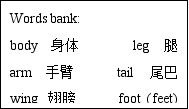Step1. Warm up & Lead in 1. T: Good afternoon, boys and girls. Do you like songs? Let’s enjoy a song: Head shoulders knees and toes. Ss: Listen, move and enjoy a song 通过欢乐的歌曲渲染学习氛围。感受新知,引出话题。 Step2. Presentation 1. T: 出示人物身体图片,提出问题: What body parts do you know? S1: I know head. S2:I know eyes. (学生学过五官名词,可能会说歌曲里听到的和课外积累的,但主要学习今天的四个新词。) 2.PPT热键出现四个身体部位单词 : car, farm—arm; red, egg—leg, look book—foot. T: I have two feet. One is my left foot, the other is my right foot. Learn to read and understand the new words: body, arm, foot, leg. 温故知新,开放式问题激活学生思维,以旧引新,学习单词。 3.组织游戏:Quick Response T: Do you remember them? Try to remember. Let’s play a game. Listen to me carefully and touch quickly. For example, “Touch your head”, you say “Touch my head” and do it quickly. Ss: 听听做做,快速反应: “Touch my …” 用游戏巩固新单词 3. T: You are so fast. Great! Now, attention. Touch your tail and wings. T: Do we have tails? Ss: 疑惑。 PPT出示tail图片 Ss: 理解新词, 学习回答We have no tails or wings. 由游戏自然引出动物身体部位,从谈论人向谈论动物过渡。 T: What animas have tails? What animals have wings? Ss: 练读单词并回答…has a (big/ long/ short) tail. T:Animals are lovely. They are our good friends. The students are talking about their animal friends today. Look! Who are they? Ss:They’re Mike/ Liu Tao/ Su Yang/Nancy. T:What body parts do you see? What animals are they talking about? Ss: A dog/ rabbit/ two fish/ parrot. 整体呈现语篇,听力理解,把握大意和相关信息 T: Who are their friends? Listen and match. Ss: Listen and match. Check. Nancy has two fish. T: Can you say it in another way? 引导学生逐幅图校对,尝试用不同表达。 Ss: Nancy likes two fish. Two fish are Nancy’s friends. 鼓励学生用多种表达陈述同样的意思,丰富学生表达。 T: Nancy like two fish. How does she talk about her fish? Please try to read her words. Ss: Work in pairs. Find difficulties. Focus on: bodies 自读第一语段,理解难点。one…the other前边已有铺垫,此处再次明晰,着重解决其读音困难;通过对比选择理解句子It has no…or… T: Work in pairs if you have any difficulties. (1) bodies (2) 示范朗读One is… the other is… There are two doors in this classroom. One is open, the other is closed. Can you try to say a sentence like me? Ss: the other They have no…or…. 尝试表达:I have two rubbers. One is blue, and the other is white. I have two eyes. One is small, the other is small, too. 运用实际生活信息引导学生交流。 (3) T: What does this sentence mean? 出现选择 A: They have no legs. But they have two arms. B: They have no legs, and they have no arms. Ss: Choose B T: How do you know Ss: Tell in Chinese. (1) 根据上下文推测句意; (2) 根据图片信息推测; 根据生活常识猜测。 阅读理解方法指导。 . T:The other three students have only one animal friend. How do they talk about their friends? Find some aspects they talk about the animals. 板书句式,找出描述纬度。 Ss: read and find the aspect about animals. Ss: Tell in Chinese. (1) 总体印象; (2) 外貌细节; 能力爱好。 指导学生把握文章脉络,找出句式,把握思维走向,为描述学生自己的动物朋友铺垫准备。 Step3. Consolidation 1.T:Different animals, different appearance. Now try to read the whole story about their animal friends. Ss: Read the text together. Read in groups of four.(together, or role reading, choose the way they prefer) 齐读、小组朗读课文。 2. T: Think and write ( P 28), try to retell the text. Ss: Fill in the blanks and retell the text. 根据文本内容印象,填空,初步复述文章。 3.T:Do you like their friends? I have an animal friend, too. 示范: T:(课件逐幅出示body等身体部位的小图片,打乱顺序) (注意描述角度更丰富) Yes, it has a small body. It has a big mouth. It has two strong feet. It has a long tail. It has no arms. But it has two wings. It can fly and talk. What is it? Do you know now? Ss: Listen and guess. An eagle? A parrot? 随着特征的逐步清晰化理解猜出答案: It’s parrot! (出现鹦鹉的完整图片) Ss: Prepare and try to describe an animal friend to all. 从理解到运用,根据老师是示范,尝试描述自己喜欢的动物。 Step6. Homework 1..Listen, read and try to retell the text. 2.Write a riddle of your animal friend. Share it with us tomorrow. 从听说读写各技能角度巩固本课所学内容,编写谜语为下节课做准备。  Unit 3 Our animal friends  It’s… It has… It can… It likes… |